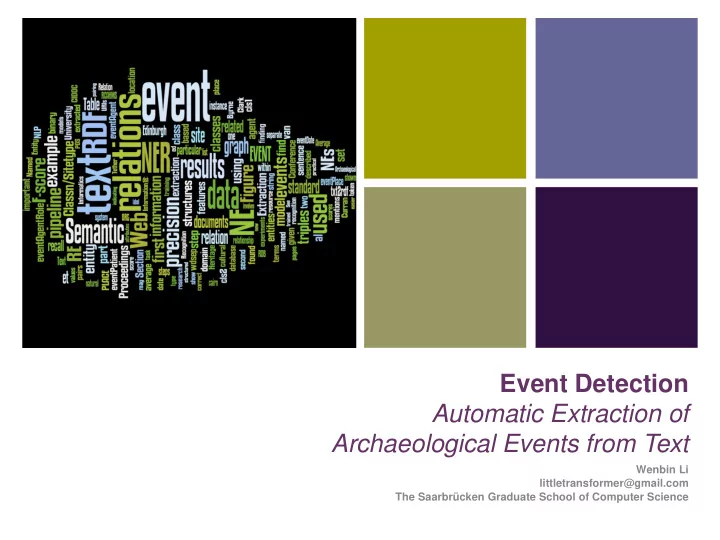

+ Event Detection Automatic Extraction of Archaeological Events from Text Wenbin Li littletransformer@gmail.com The Saarbrücken Graduate School of Computer Science
+ Outline Overview Background Semantic web Natural language processing Experiment Settings (data) Procedures Results and evaluation (Remarks) Follow-ups
+ Overview (what we do here)
+ Background Semantic Web Natural Language Processing
+ Semantic Web Reminder A group of methods and technologies to allow machines to understand the meaning – or "semantics" – of information on the World Wide Web. (Wikipedia) RDF (Resource Description Framework) A family of World Wide Web Consortium (W3C) specifications originally designed as a metadata data(data about data) model. (Wikipedia) RDF triple: subject-predicate-object More information at http://www.w3.org/RDF/
+ Example of RDF triple Statement: site123 is classified as a chambered cairn
+ Natural Language Processing Pre-processing Tokenize POS (Part-Of-Speech) tag NER (Name Entity Recognition) Find and categorize the “entities” mentioned in a text Typically include personal names, places, organization names and temporal expressions RE (Relationship Extraction) Detect and classify semantic relationship from data
+ Experiment Data Procedures Evaluation
+ Data From RCAHMS (The Royal Commission on the Ancient and Historical Monuments of Scotland, http://www.rcahms.gov.hk) One of Scotland’s 6 National Collection Recording Scotland’s places, from the Neolithic to Now
+ Procedure
+ Procedure--NER Supervised learning ( training data hand-annotated documents ) Domain specific classes ORG PERSNAME ROLE SITETYPE ARTEFACT PLACE √ √ √ SITENAME ADDRESS PERIOD DATE EVENT √ √ NE nesting [[[Edinburgh] PLACE University] ORG Library] ORG
+ Procedure--RE Focus on event relationships Attributes of event Agent Role Date Patient place Supervised learning (training data hand-annotated documents)
+ Learning process in NER & RE
+ Procedure—Example The following were found in Unst by Mr A T Cluness: a steatite dish, …
+ Procedure—Example(cont.) FIND PLACE PERSNAME ARTEFACT EVENT The following were found in Unst by Mr A T Cluness: a steatite dish, …
+ Procedure—Example(cont.) FIND PLACE PERSNAME ARTEFACT EVENT The following were found in Unst by Mr A T Cluness: a steatite dish, … Relationship Entity1 Entity2 eventLocation were found unst eventAgent were found a_t_cluness eventPatient were found steatite_dish O unst a_t_cluness O unst steatite_dish O A_t_cluness steatite_dish
+ Evaluation NER evaluation RE evaluation NER and RE combination
+ Some Results
+ Discussion of Results Weigh models towards preferring precision over recall (?)when extracting facts from text, it more important to find correct statements than to find all that are available The author claims that the good results of eventAgent and eventDate in the pipeline suggests “with more data, the pipeline is capable of delivering very useful data structure without human labor” (?)
+ Summary Practical application of NLP in event extraction in history domain
+ Extra: Follow-up Project Visualization
+ End Thank you!
Recommend
More recommend